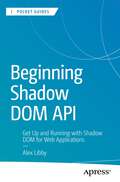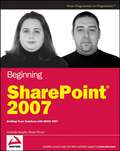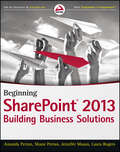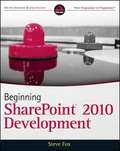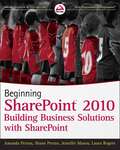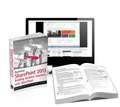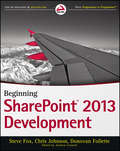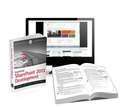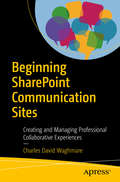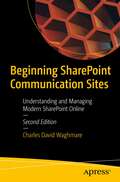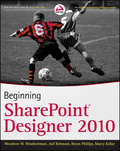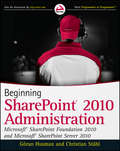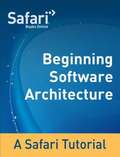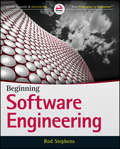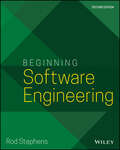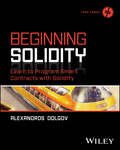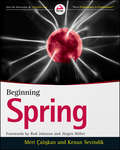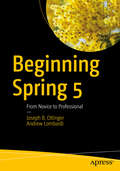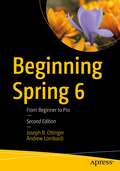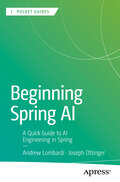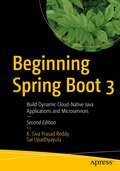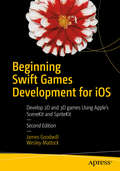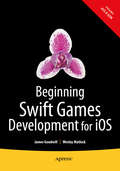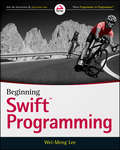- Table View
- List View
Beginning Shadow DOM API: Get Up and Running with Shadow DOM for Web Applications (Apress Pocket Guides)
by Alex LibbyLeverage the power of the Shadow DOM API to quickly create encapsulated code that keeps markup and styles separate within websites. Using little more than a text editor or free software, this project-oriented book simplifies the process of creating and manipulating the Shadow DOM API code in the browser for websites or online applications. You'll use a starting toolset to develop future projects, incorporate them into an existing workflow, and allow them to simplify complex components. This makes them more robust and less brittle when used in websites. You'll also see that websites do not have to convert the whole work process immediately; you can incorporate as little or as much as needed of the API, and build on this as your skills develop. We live in an age where speed and simplicity are of the essence. Beginning Shadow DOM API shows you the perfect way to create encapsulated code that can run in multiple frameworks with a minimum of fuss.You You'll LearnImplement the Shadow DOM API in a projectGain an appreciation of pointers using the Shadow DOM APIManage issues and security when using the Shadow DOM APIMake components and code more reusable, while maintaining desired stylingWho This Book Is ForWebsite developers who are already familiar with frameworks that Shadow DOM API, but do not want to have to use the heavy weight of a full-sized framework to add features such as DOM encapsulation to their code.
Beginning SharePoint 2007
by Amanda Murphy Shane PerranMicrosoft Office SharePoint Server 2007 has improved and changed dramatically over previous versions of the product. The capabilities of the platform have expanded greatly with the inclusion of an automated workflow engine, web content management capabilities, and a vast number of document management enhancements. However, the value of this tool to an enterprise will depend primarily on the ability of individuals in the organization to understand the features and capabilities of the platform and effectively map those to specific business requirements. This book is designed to mentor and coach business and technical leaders in an organization on the use of SharePoint to address critical information management problems. It gives detailed descriptions and illustrations of the product's functionality and also includes realistic usage scenarios to provide contextual relevance and a personalized learning experience to the reader.The mission of this book is to provide extensive knowledge to information workers and site managers that will empower them to become SharePoint Application champions in the organization. This book should be the premiere handbook of any active or aspiring SharePoint expert.To complete the exercises in this book, you should have a basic comfort level using Microsoft Office application to create content and a general understanding of how to interact with a web site through the browser. This book is intended as a starting point for any SharePoint 2007 user whether that user has never used SharePoint before or has some familiarity with a previous version and just wants to understand the differences with the new release.
Beginning SharePoint 2010
by Laura Rogers Jennifer Mason Shane Perran Amanda PerranTwo SharePoint MVPs provide the ultimate introduction to SharePoint 2010Beginning SharePoint 2010: Building Team Solutions with SharePoint provides information workers and site managers with extensive knowledge and expert advice, empowering them to become SharePoint champions within their organizations.Provides expansive coverage of SharePoint topics, as well as specialty areas such as forms, excel services, records management, and web content managementDetails realistic usage scenarios, and includes practice examples that highlight best practices for configuration and customizationIncludes detailed descriptions and illustrations of SharePoint's functionalityDesigned to mentor and coach business and technical leaders on the use of SharePoint in addressing critical information management problems within their organizations, Beginning SharePoint 2010 is sure to become the premiere handbook for any active or aspiring SharePoint expert.
Beginning SharePoint 2010 Development
by Steve FoxDiscover how to take advantage of the many new features in SharePoint 2010SharePoint 2010 is a significant leap forward from the 2007 release, and 'you will find that there are a ton of features built into the platform for you to leverage in your solution development. Because SharePoint is a broad platform that covers a lot, this book also covers quite a bit of ground. As a Wrox Beginning book, the goal of Beginning SharePoint 2010 Development is to get you started with many of the fundamentals so that you can continue on to advanced programming beyond this book.The book's goal is to quickly take you from the basics of SharePoint, to installing and configuring a development environment, and then into how you can develop for SharePoint. The book is heavy on coding exercises, but tries to stick to a common set of .NET patterns to ensure you walk away with understanding the different ways in which you can code for SharePoint. Moving from beginning to advanced means that you can expect the walkthroughs and chapters to become increasingly more complex within each chapter and throughout the book. The walkthroughs have been created to be concise and to guide you through all of the steps you must accomplish to complete a coding task.Beginning SharePoint 2010 Development is aimed at the developer who is new to SharePoint. The book assumes you have some programming experience and a passion to learn how to develop for SharePoint. But this book does not assume that you've programmed against SharePoint before. With regard to your general development background, the two assumptions in this book are that you have some familiarity with Web development, and you have an understanding of .NET programming. With regard to Web development, this book assumes that you understand HTML, and may have an understanding of Cascading Style Sheets (CSS), Extensible Markup Language/Extensible Stylesheet Language (XML/XSL), and dynamic languages such as JavaScript. You may have a light understanding of ASP.NET and are looking to apply this knowledge to the SharePoint space. In any case, you have some understanding of the fundamentals of Web and .NET development, and are looking to apply those to the SharePoint space.
Beginning SharePoint 2010: Building Business Solutions with SharePoint
by Laura Rogers Jennifer Mason Shane Perran Amanda PerranTwo SharePoint MVPs provide the ultimate introduction to SharePoint 2010 Beginning SharePoint 2010: Building Team Solutions with SharePoint provides information workers and site managers with extensive knowledge and expert advice, empowering them to become SharePoint champions within their organizations. Provides expansive coverage of SharePoint topics, as well as specialty areas such as forms, excel services, records management, and web content management Details realistic usage scenarios, and includes practice examples that highlight best practices for configuration and customization Includes detailed descriptions and illustrations of SharePoint’s functionality Designed to mentor and coach business and technical leaders on the use of SharePoint in addressing critical information management problems within their organizations, Beginning SharePoint 2010 is sure to become the premiere handbook for any active or aspiring SharePoint expert.
Beginning SharePoint 2013 Building Business Solutions eBook and SharePoint-videos.com Bundle
by Laura Rogers Jennifer Mason Shane Perran Asif Rehmani Amanda PerranLearn to build business solutions with SharePoint 2013 Now in its third edition, this perennial bestseller features a complete overhaul for the latest version of SharePoint. A must-have for building business solutions in SharePoint, real-world scenarios address critical information management problems and detailed descriptions explain how to efficiently and successfully handle these challenges. Plus, best practices for configuration and customization round out the coverage of getting started with SharePoint 2013 so that you can confidently make this platform work for your business today. Examines product functionality alongside realistic scenarios to provide you with contextual relevance Addresses managing permissions, reporting in SharePoint, and working with access services Offers updated content on working with lists, libraries, workflow, content types, and web parts Reviews social features, forms management, business connectivity services, and more Beginning SharePoint 2013 is an ideal introduction to the latest iteration of this popular content management provider.
Beginning SharePoint 2013 Development
by Steve Fox Donovan Follette Chris JohnsonA complete revision to a popular SharePoint developer's resourceFully updated for SharePoint 2013, this book is an ideal starting place for SharePoint development. Covering all the major topics that a new developer needs to know in order to get started, this resource contains 100 percent new content and addresses the major overhaul to the SharePoint 2013 platform. The team of authors, led by Microsoft's Steve Fox, presents you with a detailed overview that helps you establish a starting point for development. They then walk you through ways to advance your knowledge so that you leverage the new SharePoint 2013 features to build custom solutions.Addresses developing managed or unmanaged applicationsProvides an overview of Windows Azure for SharePointLooks at common developer tasks in SharePoint 2013Gets you started with building, packaging, and deploying SharePoint 2013 applicationsHighlights essential points of security in SharePoint 2013Touching on everything from developing applications using Office services to development workflow applications, Beginning SharePoint 2013 Development covers everything you need to know to start confidently working with the platform today.
Beginning SharePoint 2013 Development eBook and SharePoint-videos.com Bundle
by Steve Fox Donovan Follette Asif Rehmani Chris JohnsonA complete revision to a popular SharePoint developer's resource Fully updated for SharePoint 2013, this book is an ideal starting place for SharePoint development. Covering all the major topics that a new developer needs to know in order to get started, this resource contains 100 percent new content and addresses the major overhaul to the SharePoint 2013 platform. The team of authors, led by Microsoft's Steve Fox, presents you with a detailed overview that helps you establish a starting point for development. They then walk you through ways to advance your knowledge so that you leverage the new SharePoint 2013 features to build custom solutions. Addresses developing managed or unmanaged applications Provides an overview of Windows Azure for SharePoint Looks at common developer tasks in SharePoint 2013 Gets you started with building, packaging, and deploying SharePoint 2013 applications Highlights essential points of security in SharePoint 2013 Touching on everything from developing applications using Office services to development workflow applications, Beginning SharePoint 2013 Development covers everything you need to know to start confidently working with the platform today.
Beginning SharePoint Communication Sites
by Charles David WaghmareUnderstand SharePoint communication sites and create one on your own using SharePoint Home available in Office 365. This beginner's book will advise you about the ways to integrate your existing collaboration channels with SharePoint communication sites. Along the way you will see how to embed documents, videos, and real-time data from across Office 365, including documents from SharePoint, Power BI reports, Microsoft Stream videos, and Yammer discussions. The author starts by giving an introduction to SharePoint communication sites and how to create them. Next, you’ll cover various cases to understand the benefits of communicating through SharePoint communications sites. Further, you will learn how to design collaborative experiences for end users along with ways to plan social intranets. Here, you will understand how to integrate Yammer, SharePoint Online and email in order to build a collaborative experience. You will then integrate communication sites with Office 365 products for better end user collaboration. Finally, you will discover how to plan for and create communities using communication sites and learn more about social knowledge management.After reading Beginning SharePoint Communication Sites, you will be able to create and manage SharePoint communication sites and improve ways to communicate and collaborate within your organization. What You Will LearnCreate SharePoint communication sites to share information with larger and smaller groupsEnrich the end-user experience while sharing information with a bigger audience Plan digital intranets using SharePoint communication sitesDesign visually compelling intranetsTransform the way you share information within your companyDynamically pull in and display data, documents, and information via web partsIntegrate with Yammer and emails to create collaborative user experiencesWho This Book Is ForIT workers who use SharePoint and are involved in internal communication management, evangelism, digital transformation, social media, and intranet design.
Beginning SharePoint Communication Sites: Understanding and Managing Modern SharePoint Online
by Charles David WaghmareUnderstand SharePoint communication sites and create one on your own using SharePoint Home, available in Microsoft 365. This revised edition covers the new features in SharePoint communication sites and demonstrate how to effectively use them. You will also learn how to create a digital experience using SharePoint communication sites.This updated edition includes a new chapter on information management and governance, along with new topics such as seamless integration between Teams, using Power Automate and SharePoint Communication sites in tandem, and performing project and operations management activities with communication sites. Author Charles Waghmare starts by walking you through SharePoint communication sites and how to create them. Next, you’ll explore various use cases to understand the benefits of communicating through SharePoint communication sites. Further, you will learn collaborative applications like Teams and its integration with SharePoint, followed by details of compliance and governance . You will then integrate communication sites with Microsoft 365 products for better end user collaboration. Finally, you will discover how to perform your day-to-day operations tasks using communication sites.After reading this book, you will be able to create and manage SharePoint communication sites and improve ways to communicate and collaborate within your organization. What You Will Learn Create an information and communication strategy for your organization Explore digital ways of working Easily collaborate with shared information Create visually appealing communication sites to manage your day-to-day project work Efficiently manage organizational information with compliance Create centralized departmental repositories with SharePoint communication sites Learn to automate internal processes using SharePoint communication and M365 services Who This Book Is ForIT workers who use SharePoint and who are involved in internal communication management, evangelism, digital transformation, social media, and intranet design.
Beginning SharePoint Designer 2010
by Woodrow W. Windischman Bryan Phillips Marcy Kellar Asif RehmaniTeaching Web designers, developers, and IT professionals how to use the new version of SharePoint DesignerCovering both the design and business applications of SharePoint Designer, this complete Wrox guide brings readers thoroughly up to speed on how to use SharePoint Designer in an enterprise. You'll learn to create and modify web pages, use CSS editing tools to modify themes, use Data View to create interactivity with SharePoint and other data, and much more. Coverage includes integration points with Visual Studio, Visio, and InfoPath.Shows web designers, developers, and IT professionals how to use SharePoint Designer 2010 to customize Microsoft SharePoint Server 2010 and Windows SharePoint Services 4.0Covers both the design and business application of SharePoint Designer 2010Delves into modifying and enhancing every aspect of your SharePoint site--not just the look and feelExplores creating and modifying web pages, how to add interactivity with SharePoint and other data, and using CSS editing tools to modify themesWith the explosive growth in SharePoint, this book is your key to customizing your SharePoint sites with SharePoint Designer 2010.
Beginning SharePoint® 2010 AdministrationTM
by Göran Husman Christian StåhlWritten by a four-time SharePoint MVP, this book examines the differences between SharePoint Foundation (SPF) and SharePoint Server (SPS). Appropriate for consultants and IT professionals who need to understand how to plan, implement, and configure SharePoint, administrators and the support team that must know how to manage SharePoint, IT managers and project leaders, it assumes no previous knowledge of SharePoint The version adds full integration support for Microsoft Office 2010 and Visio 2010, Microsoft's new FAST search, and mobile and Groove client support.
Beginning Software Architecture
by Safari Content TeamThis is the first in a series of three tutorials that access learning resources available from Safari Books Online that cover the skills that Senior Associate-level Software Architects need to be fluent in. This tutorial contains fourteen topics that range from core project requirements, to cost and time estimates, to important aspects like security, development and deployment activities. Each topic lists its objectives along with the estimated time required to read each resource covered by the topic. Complete this tutorial and you will be well on your way to understanding what is required to become a beginning software architect.
Beginning Software Engineering
by Rod StephensBuild better software with essential software engineering techniques Beginning Software Engineering teaches you the practical, hands-on skills needed to design and build robust, efficient, and consistently reliable software. Using jargon-free English, this book uses numerous case studies to demonstrate important concepts and techniques, and describes methods that can be applied to any programming language. Each chapter concludes with a Try It Out and How It Works section where you can test your skills with practice exercises. No previous programming, development, or management experience is required for you to learn how to complete essential tasks within all development approaches including linear, waterfall, and agile. Understand the concept of software engineering Explore the pros and cons of major development approaches and learn the major tasks performed regardless of approach Discover how tasks are handled differently between approaches Written for new programmers wanting to build excellent, functional software, Beginning Software Engineering provides vital information and hands-on training.
Beginning Software Engineering
by Rod StephensDiscover the foundations of software engineering with this easy and intuitive guide In the newly updated second edition of Beginning Software Engineering, expert programmer and tech educator Rod Stephens delivers an instructive and intuitive introduction to the fundamentals of software engineering. In the book, you’ll learn to create well-constructed software applications that meet the needs of users while developing the practical, hands-on skills needed to build robust, efficient, and reliable software. The author skips the unnecessary jargon and sticks to simple and straightforward English to help you understand the concepts and ideas discussed within. He also offers you real-world tested methods you can apply to any programming language. You’ll also get: Practical tips for preparing for programming job interviews, which often include questions about software engineering practices A no-nonsense guide to requirements gathering, system modeling, design, implementation, testing, and debugging Brand-new coverage of user interface design, algorithms, and programming language choicesBeginning Software Engineering doesn’t assume any experience with programming, development, or management. It’s plentiful figures and graphics help to explain the foundational concepts and every chapter offers several case examples, Try It Out, and How It Works explanatory sections. For anyone interested in a new career in software development, or simply curious about the software engineering process, Beginning Software Engineering, Second Edition is the handbook you’ve been waiting for.
Beginning Solidity: Learn to Program Smart Contracts with Solidity (Tech Today)
by Alexandros DolgovUnlock the future of programming on the Ethereum blockchain with Solidity smart contracts Explore and learn smart contract development on the Ethereum blockchain with Beginning Solidity: Learn to Program Smart Contracts with Solidity by Alexandros Dolgov. This book is a guide to taking your first steps and becoming comfortable with Solidity programming, providing accessible learning material for existing and aspiring programmers who wish to build decentralised applications on the Ethereum platform. This book provides insights into the creation, compilation and deployment of smart contracts and decentralised applications. Beginning Solidity demystifies the complexities of the Ethereum blockchain and the Solidity language. From understanding the origins and use of money to basic blockchain concepts such as accounts, transactions, block explorers, wallets and consensus mechanisms, to applications like understanding and creating fungible (ERC-20) and Non-fungible tokens (NFTs) or developing a decentralized auction platform, Alexandros Dolgov covers it all. Through practical examples and real-world scenarios, this book equips you with the knowledge to design, develop, and deploy smart contracts and decentralized apps, positioning you at the forefront of the blockchain revolution. You'll also: Learn Solidity programming through the Foundry framework making Solidity programming incredibly accessible for those with or without prior coding experience Become comfortable with the development of Ethereum smart contracts and the deployment of decentralized applications across various sectors Stay up to date in the rapidly evolving field of blockchain technology with cutting-edge practices and adaptable learning strategies For both practicing and aspiring programmers and developers eager to explore the possibilities of the Ethereum blockchain and Solidity programming, Beginning Solidity is an essential read. Embark on an exciting journey to become proficient in creating blockchain-based applications that can transform the digital world. Grab your copy today and take the first step towards mastering the future of decentralized technology.
Beginning Spring
by Mert Caliskan Kenan Sevindik Rod Johnson Jürgen HöllerGet up to speed quickly with this comprehensive guide toSpring Beginning Spring is the complete beginner's guide toJava's most popular framework. Written with an eye towardreal-world enterprises, the book covers all aspects of applicationdevelopment within the Spring Framework. Extensive samples withineach chapter allow developers to get up to speed quickly byproviding concrete references for experimentation, building askillset that drives successful application development byexploiting the full capabilities of Java's latest advances.Spring provides the exact toolset required to build anenterprise application, and has become the standard within thefield. This book covers Spring 4.0, which contains support for Java8 and Java EE 7. Readers begin with the basics of the framework,then go on to master the most commonly used tools and fundamentalconcepts inherent in any Spring project. The book emphasizespracticality and real-world application by addressing needs such asmeeting customer demand and boosting productivity, and by providingactionable information that helps developers get the most out ofthe framework. Topics include:Dependency Injection and Inversion of ControlUnit testing Spring enabled Web Applications Data Access using Spring JDBC and ORM support along withTransaction ManagementBuilding Web Applications and RESTful Web Services with SpringMVCSecuring Web Applications using Spring SecuritySpring Expression Language with its Extensive FeaturesAspect Oriented Programming Facilities Provided by SpringAOPCaching with 3rd Party Cache Providers' SupportThe Best of the Breed: Spring 4.0The information is organized and structured an ideal way forstudents and corporate training programs, and explanations aboutinner workings of the framework make it a handy desk reference evenfor experienced developers. For novices, Beginning Spring isinvaluable as a comprehensive guide to the real-world functionalityof Spring.
Beginning Spring 5: From Novice to Professional
by Andrew Lombardi Joseph B. OttingerGet started with Spring Framework 5 and its ecosystem, with a guide to the working practices in modern development. Authors Joseph Ottinger and Andrew Lombardi will teach you how to use the Spring Framework to build Java-based applications, web applications, and microservices. You’ll see how Spring has drastically and positively affected the way we program and design applications in Java.Beginning Spring 5 discusses how you can build apps with the Spring mindset and what the benefits of that mindset are. Along the way you will learn many aspects of the Spring ecosystem with easy-to-understand applications designed to teach you not only the technology, but also the practices that benefit the most from Spring.What You Will LearnDiscover the most common use cases encountered in the real world Create reliable, tested, modular software, building skills that will translate well across all languages and environments.Integrate and use data access and persistence frameworks such as Hibernate, JPA, and MongoDBProgram functional or reactive Java with the latest Spring 5 features including WebFlux Who This Book Is ForThose who are new to Spring or for those who have experience with Spring but want to learn what's new in Spring 5. This book assumes you have some prior coding experience in Java at least.
Beginning Spring 6: From Beginner to Pro
by Andrew Lombardi Joseph B. OttingerThis book will teach you how to use the Spring Framework to build Java-based applications, web applications, and microservices. Aimed at beginners, it has been revised and expanded to reflect the latest features and best practices for Spring 6. Authors Joseph Ottinger and Andrew Lombardi will get you started using Spring Framework 6 and its ecosystem, walking you through all the best practices in modern application development. You’ll see how Spring has drastically and positively affected the way applications are designed and programmed in Java, and how to build apps with the Spring mindset. Along the way, you will learn many aspects of the Spring ecosystem with easy-to-understand applications designed to teach you not only the technology, but also the practices that benefit the most from Spring. Starting with the basics, you’ll learn gradually, including topics such as the configuration and declaration of beans, the application lifecycle, how todeploy a Spring application into a Java EE application, Spring Reactive, Spring Web, Spring Boot, and Spring Cloud. After completing this book, you’ll be prepared to develop your own scalable, modular Spring-based applications. What You Will Learn Discover the most common use cases encountered in the real worldLearn the proper way of testing with the Spring frameworkCreate reliable, modular softwareBuild skills that will translate well across all languages and environmentsIntegrate and use data access and persistence frameworks such as Hibernate, JPA, and MongoDBGet started with the most common, most-used Spring features Who This Book Is For Those who are new to Spring or for those who have experience with Spring but want to learn what's new in Spring 6. This book assumes you have some prior coding experience inJava, but many core concepts in Java are discussed as they’re encountered.
Beginning Spring AI: A Quick Guide to AI Engineering in Spring (Apress Pocket Guides)
by Andrew Lombardi Joseph OttingerDiscover how to use Large Language Models in the Spring Framework. This quick guide equips developers with insights into the strengths and limitations of Spring AI and how to leverage the model for typical use cases. First, you will orient yourself to the new and exciting landscape of AI and Spring integration. You will learn how to issue simple queries, asking the right questions to get the results you want. From there, you will be empowered to select the right model for functionality and refinement, building a simple yet effective chat bot using real-world examples. Additionally, the book explores how to generate images, refine them, and how to send source images when appropriate. Lastly, the book focuses on how Spring AI and LLMs affect the developer landscape, including pitfalls and ethical concerns. Designed for fast adoption, this book provides targeted guidance on integrating AI and LLMs into your projects within days. Through a pragmatic approach, it emphasizes direct utilization of the API. What You Will Learn Explore popular use cases for LLMs Gain insight into the Spring AI module, including its capabilities and limitations Know how to create effective queries and interactions for AI-driven conversations and image generation Discover strategies for selecting an appropriate LLM service and model Acquire skills to AI-proof your job and understand why it is NOT a replacement What This Book Is Spring developers who are new to AI and focused on the essentials without exhaustive framework details. This is an optional supplement to the more comprehensive Apress book, Beginning Spring 6.
Beginning Spring Boot 3: Build Dynamic Cloud-Native Java Applications and Microservices
by K. Siva Reddy Sai UpadhyayulaLearn the Spring Boot 3 micro framework and build your first Java-based cloud-native applications and microservices. Spring Boot is the lightweight, nimbler cousin to the bigger Spring Framework, with plenty of "bells and whistles." This updated edition includes coverage of Spring Native, which will help you speed up your Spring Boot applications, as well as messaging with Spring Boot, Spring GraphQL, Spring Data JDBC and reactive relational database connectivity (R2DBC) with SQL. This new edition also covers enhancements to actuator endpoints, MongoDB 4.0 support, layered JAR and WAR support, support to build OCI images using Cloud Native Build Packs, changes to the DataSource initialization mechanism, and how bean validation support has moved to a separate spring-boot-validation-starter module. This book will teach you how to work with relational and NoSQL databases for data accessibility using Spring Boot with Spring Data, how to persist data with the Java Persistence APIs (JPA), MyBatis, and much more. You'll learn how to enhance your native cloud or web applications with other APIs such as REST and how to build reactive web applications using Spring Boot with WebFlux. Finally, you'll learn how to test applications using JUnit 5, as well as how to secure and deploy your application or service to cloud providers like Heroku. After reading Beginning Spring Boot 3, you'll have the skills needed to start building your own Spring Boot cloud-native, Java-based applications and microservices with confidence, and to take the next steps in your career. What You Will Learn Explore the Spring Boot 3 micro framework using Spring Native for faster, better performanceBuild cloud-native Java applications and microservices with Spring BootWork with relational and NoSQL databases using Boot with Spring DataCreate reactive web applications using Spring's WebFluxSecure, test, and deploy applications and services Who This Book Is For IT professionals such as cloud architects, infrastructure administrators, and network/cloud operators
Beginning Spring Data: Data Access and Persistence for Spring Framework 6 and Boot 3
by Andres SaccoUse the popular Spring Data project for data access and persistence using various Java-based APIs such as JDBC, JPA, MongoDB, and more. This book shows how to easily incorporate data persistence and accessibility into your microservices, cloud-native applications, and monolithic enterprise applications. It also teaches you how to perform unit and performance testing of a component that accesses a database. And it walks you through an example of each type of SQL and NoSQL database covered. After reading this book, you’ll be able to create an application that interacts with one or multiple types of databases, and conduct unit and performance testing to analyze possible problems. Source code is available on GitHub.What You’ll LearnBecome familiar with the Spring Data project and its modules for data access and persistenceExplore various SQL and NoSQL persistence typesUncover the persistence and domain models, and handle transaction management for SQLMigrate database changes and versioning for SQLDive into NoSQL persistence with Redis, MongoDB, Neo4j, and CassandraHandle reactive database programming and access with R2DBC and MongoDBConduct unit, integration, and performance testing, and moreWho This Book Is ForExperienced Java software application developers; programmers with experience using the Spring framework or the Spring Boot micro framework
Beginning Swift Games Development for iOS: Develop 2D and 3D games Using Apple's SceneKit and SpriteKit
by James Goodwill Wesley MatlockGame apps are one of the most popular categories in the Apple iTunes App Store. Well, the introduction of the new Swift programming language will make game development even more appealing and easier to existing and future iOS app developers. In response, James Goodwill, Wesley Matlock and Apress introduce you to this book, Beginning Swift Games Development for iOS. In this book, you'll learn the fundamental elements of the new Swift language as applied to game development for iOS. In part 1, you'll start with a basic 2D game idea and build the game throughout the book introducing each SpriteKit topic as we add new functionality to the game. By the end of the book, you'll have experience with all the important SpriteKit topics and have a fully functional game as a result. In part 2 of this book, you'll learn 3D game development using Apple's SceneKit framework and the Swift programming language. And, you'll follow the same pattern we used for part 1. After reading and using this book, you'll have the skills and the code to build your first 2D and then 3D game app that you can run on any iOS enabled device and perhaps sell in the Apple iTunes App Store. What you'll learn What is the Swift Programming Language How to apply it to iOS game development How to use SpriteKit with Swift How to use SceneKit with Swift How to build your first 2D game app using SpriteKit and Swift How to build 3D game from 2D using SceneKit and Swift Who this book is for This book is for iOS app developers new to Swift or for those thinking of doing iOS game app development for the very first time. Table of Contents Part I 1. Setting up your First Game Scene and Adding your First Sprite 2. Digging into the SpriteKit Scene 3. Physics and Collision Detection 4. Adding Scene Scrolling and Game Control 5. Actions and Animations 6. Adding Particle Effects to Your Game with Emitter Nodes 7. Points, Scoring and Sounds 8. Transitioning Between Scenes 9. Refactoring and Best Practices Part II 10. Creating Your First SceneKit Project 11. Building the Scene 12. Lighting, Camera and Materials in SceneKit 13. Animating SceneKit Models 14. Adding Hit Testing and Collision Detection 15. Using SpriteKit within a SceneKit Scene 16. Advanced Topics and Tips 17. Appendix A: The Swift Programming Language
Beginning Swift Games Development for iOS: Updated For Swift 3
by James Goodwill Wesley MatlockGame apps are one of the most popular categories in the Apple iTunes App Store. Well, the introduction of the new Swift programming language will make game development even more appealing and easier to existing and future iOS app developers. In response, James Goodwill, Wesley Matlock and Apress introduce you to this book, Beginning Swift Games Development for iOS. In this book, you'll learn the fundamental elements of the new Swift language as applied to game development for iOS. In part 1, you'll start with a basic 2D game idea and build the game throughout the book introducing each SpriteKit topic as we add new functionality to the game. By the end of the book, you'll have experience with all the important SpriteKit topics and have a fully functional game as a result. In part 2 of this book, you'll learn 3D game development using Apple's SceneKit framework and the Swift programming language. And, you'll follow the same pattern we used for part 1. After reading and using this book, you'll have the skills and the code to build your first 2D and then 3D game app that you can run on any iOS enabled device and perhaps sell in the Apple iTunes App Store. What you'll learn What is the Swift Programming Language How to apply it to iOS game development How to use SpriteKit with Swift How to use SceneKit with Swift How to build your first 2D game app using SpriteKit and Swift How to build 3D game from 2D using SceneKit and Swift Who this book is for This book is for iOS app developers new to Swift or for those thinking of doing iOS game app development for the very first time. Table of Contents Part I 1. Setting up your First Game Scene and Adding your First Sprite 2. Digging into the SpriteKit Scene 3. Physics and Collision Detection 4. Adding Scene Scrolling and Game Control 5. Actions and Animations 6. Adding Particle Effects to Your Game with Emitter Nodes 7. Points, Scoring and Sounds 8. Transitioning Between Scenes 9. Refactoring and Best Practices Part II 10. Creating Your First SceneKit Project 11. Building the Scene 12. Lighting, Camera and Materials in SceneKit 13. Animating SceneKit Models 14. Adding Hit Testing and Collision Detection 15. Using SpriteKit within a SceneKit Scene 16. Advanced Topics and Tips 17. Appendix A: The Swift Programming Language
Beginning Swift Programming
by Wei-Meng LeeEnter the Swift future of iOS and OS X programmingBeginning Swift Programming is your ideal starting point for creating Mac, iPhone, and iPad apps using Apple's new Swift programming language. Written by an experienced Apple developer and trainer, this comprehensive guide explains everything you need to know to jumpstart the creation of your app idea. Coverage includes data types, strings and characters, operators and functions, arrays and dictionaries, control flow, and looping, with expert guidance on classes, objects, class inheritance, closures, protocols, and generics. This succinct -- yet complete -- overview provides a detailed introduction to the core features of Swift.Apple developed Swift to address the limitations of Objective-C, and add features found in more complex languages like Python. The results is simpler, cleaner, more expressive code with automatic memory management, functional programming patterns, and more, including built-in features that make Swift apps faster, scalable, and more secure. This book explains it all, helping developers master Apple's new language.Become fluent with syntax that's easier to read and maintainUnderstand inferred types for cleaner, less mistake-prone codeLearn the key features that make Swift more expressive than Objective-CLearn the new optional types in Swift that make your code more resilientUnderstand the key design patterns in iOS and Mac OS programming using protocols and delegatesLearn how to use generics to create highly reusable codeLearn the new access controls mechanism in SwiftGet up to speed quickly to remain relevant and ahead of the curve.
